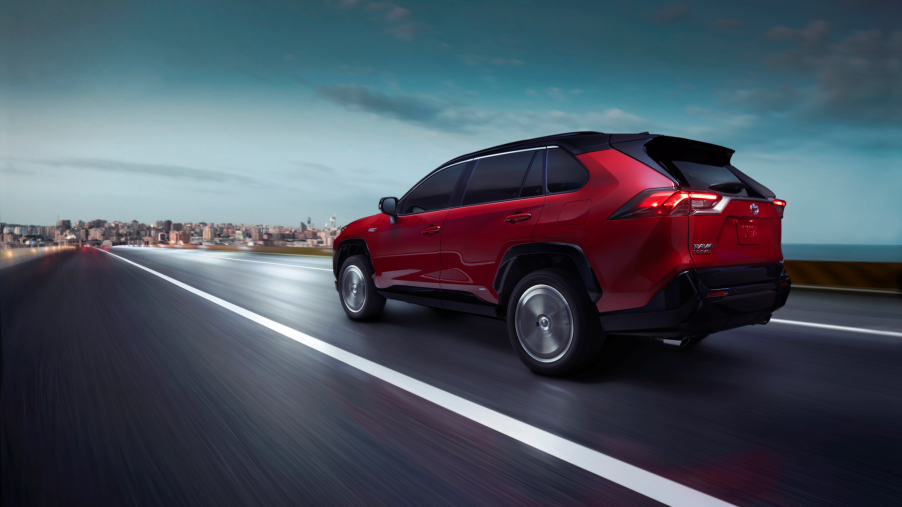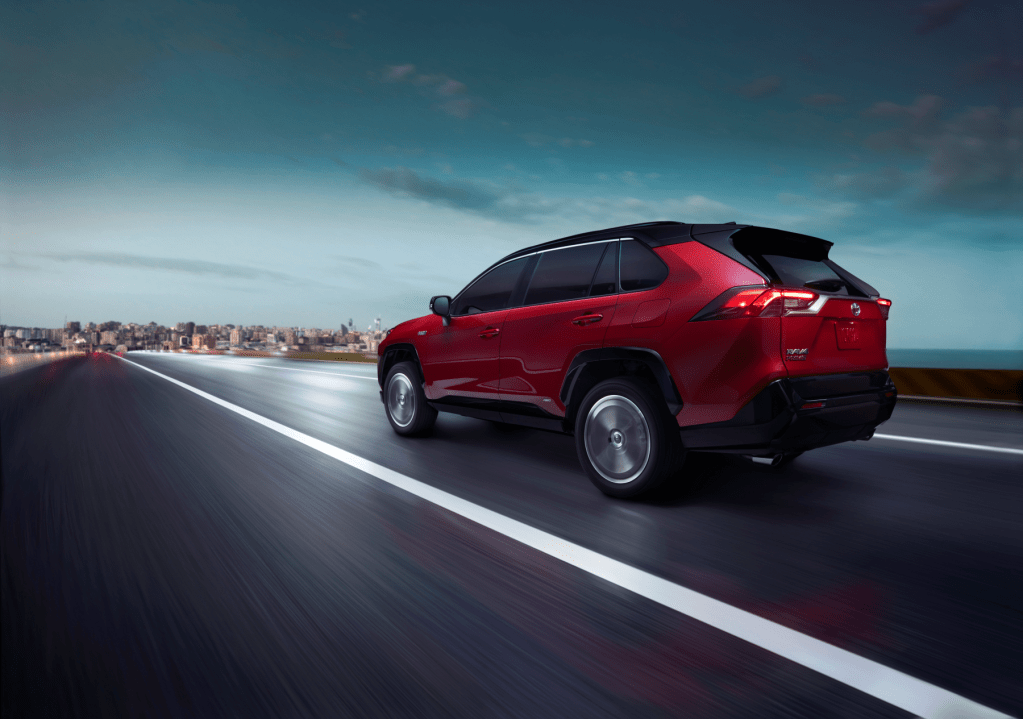
Is the Toyota RAV4 Prime Bigger Than the RAV4 Hybrid?
When you buy a hybrid electric vehicle (HEV), you’re usually buying a vehicle a bit bigger than its purely gas-guzzling counterpart. HEVs must make room for the gasoline engine, motor (or motors), and the electric battery that power the vehicle. However, what about a plug-in hybrid electric vehicle (PHEV)? PHEVs typically have a larger battery than hybrids, allowing them to travel a longer distance on pure battery power. Additionally, a PHEV needs room for an onboard charger and an inverter, among other components. One might naturally think that the PHEV would be the larger vehicle, but, as with the Toyota RAV4 Prime (a PHEV) and the RAV4 Hybrid, this is not always the case.
The 2021 Toyota RAV4 Prime

With a wheelbase of 105.9 inches and a total length of 181 inches, the RAV4 Prime is the kind of vehicle prospective buyers looking for cargo room need. The standard RAV4 Prime comes with a 2.5-liter I-4 engine, AWD, 17-inch wheels, and an eight-speed automatic transmission. It produces 302 horsepower and has a 42-mile electric-only range and a 600-mile total driving range.
The five-seater affords owners a generous 33.4 cubic feet of cargo space, which expands to 63.1 cubic feet with the back row down, as well as 41 inches of legroom in the front and 37.8 inches in the back. The interior is filled with soft materials that add to rider comfort, and controls are laid out in a simple, uncluttered design. The driver and passengers are treated to a standard 7-inch touchscreen, compatible with Android Auto, Apple CarPlay, and Bluetooth. Additionally, higher-level trims upgrade the standard 7-inch screen with an 8-inch one and increase the cluster display size from the standard 4.2 inches to 7 inches.
The standard RAV4 itself boasts some impressive safety features, such as a five-star safety rating from the National Highway Traffic Safety Administration and a Top Safety Pick designation from the Insurance Institute for Highway Safety. Whether a RAV4 Prime or RAV4 Hybrid, each model includes lane-keeping assistance, automatic emergency braking, adaptive cruise control, and lane centering as standard features. Furthermore, except for the base model, every trim comes with rear cross-traffic alert and blind-spot monitoring.
The 2021 Toyota RAV4 Hybrid
Advanced safety features and technology are not the main points of differentiation between the RAV4 Prime and the RAV4 Hybrid. The key differences lie in their powertrain, performance, interior cargo room, price, and trim levels. The Hybrid sports a 2.5-liter I-4 engine and produces 219 horsepower. It comes standard with AWD, delivers 41 mpg in the city and 38 mpg on the highway, and provides owners with 37.6 cubic feet of cargo space (69.8 cubic feet with the back row folded down).
Prospective buyers considering either vehicle will also factor price and ownership costs into their decision. The RAV4 Hybrid comes in significantly cheaper at a starting MSRP of $28,500, as per U.S. News and World Report. As the RAV4 Prime starts at $38,100, it may turn off budget-conscious shoppers. Still, the higher initial price may be offset by fuel cost savings over time. For a driver with a daily commute of 20 to 30 miles, overnight and afternoon charging can save them a pretty penny in fuel costs.
The RAV4 Hybrid also comes in two trims beyond the base model LE: the XLE and the XLE Premium. The XLE’s interior materials are of higher quality than those of the LE, and it comes with a sunroof, heated door mirrors, and fog lights. In addition to these XLE features, the XLE Premium upgrades the interior materials even further and includes amenities like 18-inch wheels and front and rear parking assistance. Meanwhile, the RAV4 Prime is available in an SE and XSE trim, in addition to the LE base model. In addition to higher-quality interior trim, the SE features a sunroof and 18-inch wheels, while the XSE adds 19-inch wheels, parking assistance, and a voice-activated navigation system.
So, which RAV4 is bigger?
Conventional wisdom would hold that the RAV4 Prime would be the larger vehicle. After all, more room is needed for the larger battery and necessary plug-in components. However, by examining both vehicles’ total wheelbase and length, they are the same size. The RAV4 Prime and RAV4 Hybrid share the same total width and height as well.
Rather than manufacture a larger PHEV, Toyota decided to reduce RAV4 Prime owners’ cargo space to account for the extra powertrain volume needed. From a production standpoint, this decision was a smart one. Manufacturing two different-sized vehicles would have increased manufacturing and distribution costs and the risk of production errors.
However, the RAV4 Prime and RAV4 Hybrid’s differences require scrutiny before purchasing despite their shared dimensions. The standard Toyota RAV4 itself is Toyota’s best-selling SUV as it has garnered considerable critical and consumer praise. As such, both RAV4 variants are solid vehicles, but depending on a buyer’s priorities, one may be considerably more attractive than the other.


